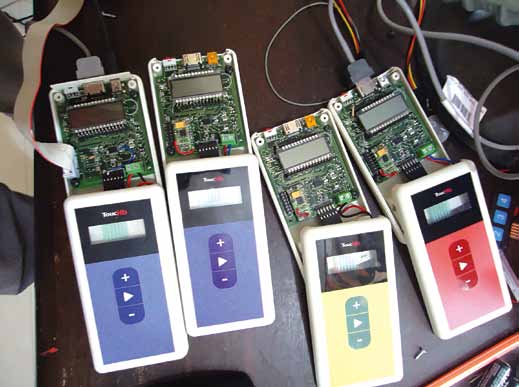
Say hello to ToucHb—a prick-free blood testing device brought to you by Biosense Technologies. ToucHb can measure your blood hae-moglobin, oxygen saturation, temperature and pulse rate all without pricking for blood. A team of three—engineer Myshkin Ingawale and doctors Abhishek Sen and Yogesh Patil—was behind making this product from the ground up.
What led the team to come up with this idea? Myshkin narrates, “In 2009, I had gone to visit my friend Abhishek in Parol—a two-hour drive from Mumbai. He was interning at the place and when I reached Parol, I had to wait for him as he was busy helping deliver a baby. Afterwards, he came out ashen-faced and informed me that both the mother and baby had died of something called post-partum haemorrhage, which is basically uncontrollable bleeding. What was shocking was that it was caused by undiagnosed anaemia.”
The news that someone could die of anaemia—a completely diagnosable and curable disease—shocked Myshkin and made him look for a solution. He asked his mother, a paediatrician, and found that testing for anaemia involves sending a blood sample through a Coulter counter. But the nearest such machine was in Mumbai and it wasn’t a viable solution to keep using the machine to have every person tested for anaemia. He contacted his two friends and started searching for practical designs for the device.
[stextbox id=”info” caption=”Photoplethysmography basics”]Photoplethysmography (PPG) is a simple and low-cost optical technique that can be used to detect blood volume changes in the microvascular bed of tissue. It is often used non-invasively to make measurements at the skin surface. The PPG waveform comprises a pulsatile (AC) physiological waveform attributed to cardiac synchronous changes in the blood volume with each heart beat, and is superimposed on a slowly varying (DC) baseline with various lower-frequency components attributed to respiration, sympathetic nervous system activity and thermoregulation.
PPG technology is used in a wide range of commercially available medical devices to measure oxygen saturation, blood pressure and cardiac output, assess autonomic function and also detect peripheral vascular disease.[/stextbox]
Dr Sen says, “In India, public healthcare runs on the ASHA worker and not on the doctor. So when our team convened to design a solution for this problem, we knew that whatever we created had to be prickless (to avoid medical waste), simple enough for the ASHA worker to operate and small enough for her to carry in her kit.”
ToucHb features
ToucHb is a handheld battery-operated device. Total blood haemoglobin is used for the diagnosis of anaemia. (The WHO qualifies any pregnant woman with Hb level of less than 11 grams per decilitre of blood as anaemic.)
TouchHb works on the principle of ‘photoplethysmography.’ Basically, it works by radiating light of three different wavelengths onto the finger, and through the tissue of the patient’s finger. Once this is done, based on the amount of light transmitted, absorbed and scattered, one can figure out the amount of haemoglobin in blood. Haemoglobin has a characteristic absorbance. For estimation of oxygen saturation, the technique is similar to the one used in pulse oximeters. While a pulse oximeter is not able to measure total haemoglobin, ToucHb is designed to do that.
Obstacles
Since non-invasive procedures for the masses is still a field in its infancy, developing the device was not without its share of challenges.

Dr Abhijeet says, ”We often joke that we failed 32 times but in reality we probably failed many more times—maybe many times each day! First, the basic science—the core R&D itself—was a challenge. All this ‘optical’ stuff for a bunch of relatively inexperienced doctors and engineer meant that we were walking in the dark.”
Dr Yogesh adds, “There were small nitty gritties related to production and assembly lines—a millimetre here and a rupee difference there—and suddenly we were struggling both on the technical and costing sides! We had to learn as we went along—how to identify signs of error, rectify and make the hardware reliable. We learnt the best way—by being wrong!”
Roadmap
ToucHb is being produced and sold directly to clinics, which then use it for screening and monitoring of anaemia in their patients. But the team has a bigger plan—to scale up the production from 30-40 a batch to more than 1000 a batch. This will involve putting in place a quality management system, something which will take time.
“Apart from scaling up the production, one of the big steps for us is to partner with different international and national health agencies to under-stand the best way to create an impact with this device. The healthcare ecosystem is a complex thing—protocols are designed for good reasons, and we need to work jointly with experienced public health experts to modify the existing system and make small incremental tweaks in the way point-of-care community health works,” says Dr Patil.
The ToucHb Version 1 has already been released. So what next?
Myshkin shares, “As with any technology, you have to keep upgrading, making it better to avoid obsolescence. So watch out for even more feature-rich Version 2, a few months down the road! I would love to tell you about the features we are planning to introduce in subsequent versions, but we ourselves are not sure about which ones will make the cut.”







